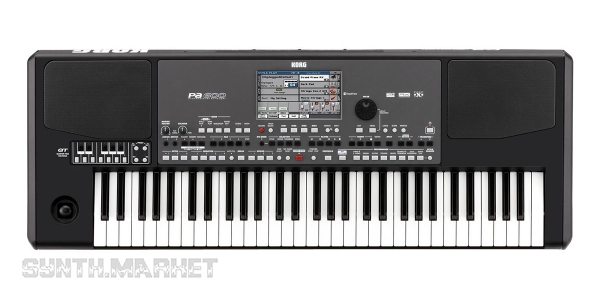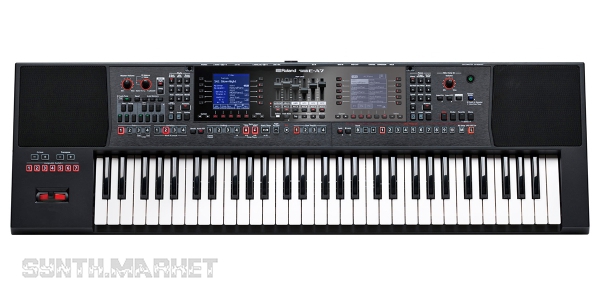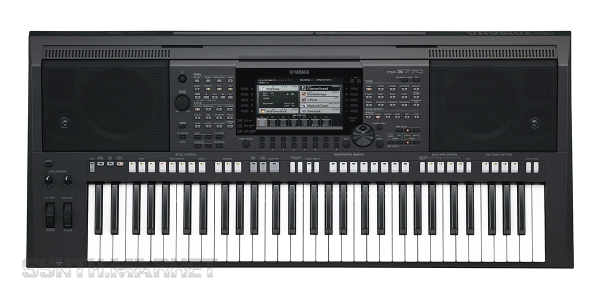
 61-key Korg Pa600 is a true arranger’s friend – it delivers as much as it should for this price being absolutely honest: compact shape, extremely natural sounds and a wide range of styles. Korg improved technology is responsible for the authentic voices and dynamic performance: Real eXperience and Defined Nuance Control sound engine. Pa600 powerful arranger/workstation is easily controlled – 360 styles, comprehensible navigation with the TouchView display help and more than 950 sounds (user sounds and performance sets can be added as well).
61-key Korg Pa600 is a true arranger’s friend – it delivers as much as it should for this price being absolutely honest: compact shape, extremely natural sounds and a wide range of styles. Korg improved technology is responsible for the authentic voices and dynamic performance: Real eXperience and Defined Nuance Control sound engine. Pa600 powerful arranger/workstation is easily controlled – 360 styles, comprehensible navigation with the TouchView display help and more than 950 sounds (user sounds and performance sets can be added as well).
Any of the 360 styles can be turned into your own, each offers 3 intro and 3 outro types, 4 variations as well as 4 fills and breaks. Favourite styles are simply stored and easily accessible.
Korg Pa600 has a unique guitar mode (Guitar Mode 2) which renders pressed keys into plausible strings voices in quite a convincing manner. Thus playing a chord you can hear the notes more of strumming than arpeggiating like the keys do.
Korg Pa600 numbers 125 built-in effects types (4 Stereo Master FX), each track has its own equalizer (4-band EQ and limiter at the master output). There’s a 16-track sequencer. Besides that there is a built-in MP3 player with Transpose and Tempo Change functions which gives the opportunity to play any key and tempo, fully programmable SongBook data base, dual-speaker sound system (15W). You could acquire pedals (expression, damper, footswitch) separately.
 A bit more expensive but still within the same price range – Roland E-A7, another 61-note arranger. Roland guarantees fast and intuitive operation with E-A7 thanks to the logical display layout as well. Styles occupy the left part of the panel, sounds which total 1500 of them are on the right side, the majority of the functions are assigned to the quick access buttons. WAV files can be imported without any problem so that you could create your own instruments or make samples on the spot using the keyboard which weighs about 8kg – it’s portable enough for you to take it in tour. There’s a microphone input as well with assigned voice effects.
A bit more expensive but still within the same price range – Roland E-A7, another 61-note arranger. Roland guarantees fast and intuitive operation with E-A7 thanks to the logical display layout as well. Styles occupy the left part of the panel, sounds which total 1500 of them are on the right side, the majority of the functions are assigned to the quick access buttons. WAV files can be imported without any problem so that you could create your own instruments or make samples on the spot using the keyboard which weighs about 8kg – it’s portable enough for you to take it in tour. There’s a microphone input as well with assigned voice effects.
Despite the emphasis which E-A7 makes on Western music its attention also covers an impressive select of backing styles from other parts of the world recorded by professionals from Asia, Middle East, Europe and South America. The sounds are categorized by regions, so together with essential electric piano, organ and wind voices there are authentic instruments of Indonesia, India, Vietnam and Eastern Europe.
Owing to the WAV file import function you can use the libraries of other musicians, and the sampling function will help to make up your own sounds including drum beat and backing vocal.
Two displays are each responsible for their own panel part – one is for the styles and the other is for the sounds. E-A7 took care of a shortcut menu bringing all the “first aid” functions for your performance up on the surface: 6 pads trigger audio samples and MIDI phrases, 6 sliders control the volume of each part, 7 assignable buttons at the discretion of the user and a sufficient number of single-task buttons. Getting back to the microphone input and dedicated controllers we should note that the adjustment is carried out with just a turn of a knob so no menu needed; a wide choice of editable reverbs and delays will polish the resulting sound.
The onboard player of E-A7 reads SMF (Standard MIDI Files), MP3 and WAV. Playback opportunities allow to repeat a certain segment or to hop from one to another, and you can also remove any vocal part in a WAV file using Centre Cancel option. Having recorded you performance in WAV you can easily save it via USB.
Within a program different settings can be saved including positioning of such controllers as Part, Auto Fill and Input EFX which makes it easier to set your keyboard up according to each song during the performance.
We might as well drop Roland E-09 in the list to examine it properly but it has already left the market so there’s no reason to put it in the review among new and yet alive ones. We’ll also bypass BK series considering it has a slightly different purpose – these are auto-accompaniment instruments. Although they’ve got some functions of an arranger they appear to be the keyboards for live performing.
 Yamaha also has got something to hit the list with – welcome another affordable representative PSR-S770 which came out a while ago. And until it was released that same set of advantages it can offer used to cost so much more. PSR-S770 is proving to us that we can be quite happy with an arranger for such a price. The instrument comprised that familiar Tyros series sound including Super Articulation Voices and Organ flutes.
Yamaha also has got something to hit the list with – welcome another affordable representative PSR-S770 which came out a while ago. And until it was released that same set of advantages it can offer used to cost so much more. PSR-S770 is proving to us that we can be quite happy with an arranger for such a price. The instrument comprised that familiar Tyros series sound including Super Articulation Voices and Organ flutes.
The model offers two assignable controllers for live performance, mod wheel and two assignable pedal inputs. New “DJ styles” concept frees you from constant watching the chords change while it supplies you with a collection of mindfully prepared chord progressions. You can lose yourself to music, feel at ease with it, nothing will distract you from tunes or the actual theme, all you’ll need are Live controllers though you may also trigger external audio sources with multipads if you want.
Large enough LCD monitor allows you to control the process right off during the performance letting you to access basic functions at a go. Voice & Style Expansion Packs will help PSR-S770 work for you because they’ll give you the collection of presets from all over the world. If you want more diversity you can use Yamaha Expansion Manager 2.3 or a later version in order to integrate the keyboard with your computer and deploy its full memory potential (160Mb).
PSR-S770 features microphone and guitar input allowing to add vocal or real strings to your playing and then transform the signal the way you like it applying assignable effects.
USB audio player of PSR-S770 possesses vocal remover, time stretch and pitch shift. The keyboard could also make use of Yamaha Chord Tracker application due to which you may track and fix chord sequences in any audio record saved in the instrument.
Funny but Yamaha obstinately goes on with their outworn AWM engine (though with some updating) implanting it in every new PSR-S unit. This technical solution can boast of a 30-year mileage already but Yamaha still distance their arrangers from professional synthesizers which offer AWM2.
We’ve reviewed only 3 bright representatives among affordable high quality arrangers and each has its own inarguable pluses. We didn’t put here Ketron as an honorable mention because it didn’t fit our intention – this Italian brand has nothing to respond to Japanese companies with (it’s just that great Ketron units are a bit more expensive). The famous Japanese trio is going to rule that segment as it always did. Will there ever be an alternative? We doubt it so much.

